Recently, I made some stacked
pipes and I-beams for use in my modern games, such as Super System 3
and No More Room in Hell. I figured I’d share it with you. It’s not
hard to do and I’m pretty happy with the results.
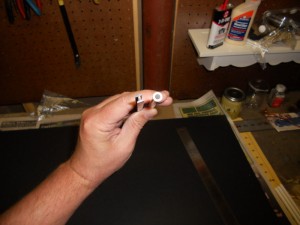
First, you’ll need some plastic rods, like the ones shown here. I picked mine up at a model railroad shop, but they’re available at most hobby stores, too. I chose a size compatible with my chosen gaming scale, 28mm. They cost me a little over a buck apiece.

The rods I bought are about 15″ long. You’ll also need a ruler and a small hobby saw, shown above.

Measure out the length you want for the pipes and I-beams. I chose 5″ pipes and 4″ girders.
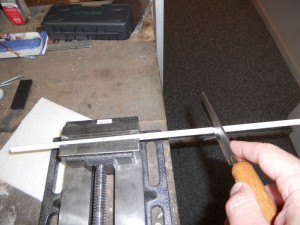
Once you’ve made your mark, cut the pipes to the desired length. Remember that you’ll likely have pipes of slightly different sizes when you’re done, as the saw blade is probably thinner that the mark you made. You may need to trim a bit when you’re done so they all measure up.

Once they’re cut, stack them up however you want and glue them together.
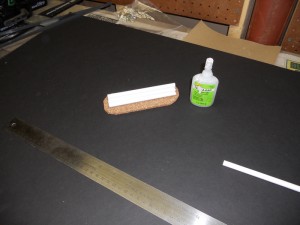
Base them on whatever you want. I chose cork tile, but Masonite would probably be better. I just didn’t feel like messing around with a jigsaw if I didn’t have to.
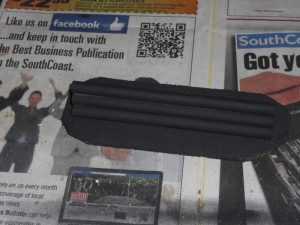
I primed mine black. Remember to get inside the tubes, or it will look weird from the front when you paint it.
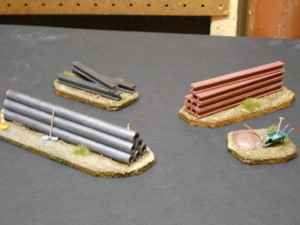
Here are the results after painting and basing. I used some O Scale Railroad scenery (the tools, cones and wheelbarrow) to spiff up the final presentation. Since I cut them shorter than the pipes, I was able to make a smaller stack of I-beams with what I had left over. You could make these in a day or so, allowing for priming and painting.
Nice work.
As a cheaper alternative, use can use drinking straws for pipes. After priming them black (and inside the ends of the tubes), you can paint them blue for water pipes, purple for reclamation water pipes, or grey for concrete sewer pipes.
Also, if you don't have the platic 'I-beams' handy, you can make them by glueing 3 pieces of thin balsa wood strip (2 narrow, and 1 wider) together into the 'I' shape. Then prime black and paint as you wish. (red-brown is probably the most common color, as that is the color of most structural steel primers.)

First, you’ll need some plastic rods, like the ones shown here. I picked mine up at a model railroad shop, but they’re available at most hobby stores, too. I chose a size compatible with my chosen gaming scale, 28mm. They cost me a little over a buck apiece.

The rods I bought are about 15″ long. You’ll also need a ruler and a small hobby saw, shown above.

Measure out the length you want for the pipes and I-beams. I chose 5″ pipes and 4″ girders.

Once you’ve made your mark, cut the pipes to the desired length. Remember that you’ll likely have pipes of slightly different sizes when you’re done, as the saw blade is probably thinner that the mark you made. You may need to trim a bit when you’re done so they all measure up.

Once they’re cut, stack them up however you want and glue them together.

Base them on whatever you want. I chose cork tile, but Masonite would probably be better. I just didn’t feel like messing around with a jigsaw if I didn’t have to.

I primed mine black. Remember to get inside the tubes, or it will look weird from the front when you paint it.

Here are the results after painting and basing. I used some O Scale Railroad scenery (the tools, cones and wheelbarrow) to spiff up the final presentation. Since I cut them shorter than the pipes, I was able to make a smaller stack of I-beams with what I had left over. You could make these in a day or so, allowing for priming and painting.
Nice work.
As a cheaper alternative, use can use drinking straws for pipes. After priming them black (and inside the ends of the tubes), you can paint them blue for water pipes, purple for reclamation water pipes, or grey for concrete sewer pipes.
Also, if you don't have the platic 'I-beams' handy, you can make them by glueing 3 pieces of thin balsa wood strip (2 narrow, and 1 wider) together into the 'I' shape. Then prime black and paint as you wish. (red-brown is probably the most common color, as that is the color of most structural steel primers.)
No comments:
Post a Comment